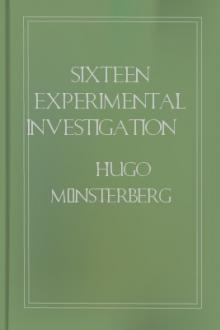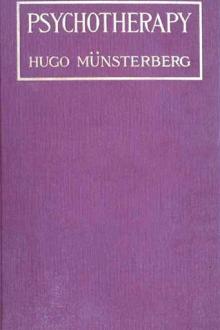Sixteen Experimental Investigations from the Harvard Psychological Laboratory by Hugo Münsterberg (good novels to read in english TXT) 📖

- Author: Hugo Münsterberg
- Performer: -
Book online «Sixteen Experimental Investigations from the Harvard Psychological Laboratory by Hugo Münsterberg (good novels to read in english TXT) 📖». Author Hugo Münsterberg
opposed to D.; in 30 per cent, of cases, D. of glance opposed
to D. of body; least used, V. (1 per cent.).
IV. One case only.
V. (D. = .) Most used element, Ms., in 73 per cent. of cases
opposed to D.; in 40 per cent. of cases, D. of glance opposed
to D.; in 28 per cent. Ms. + D. of glance opposed to D.; least
used element, V. (15 per cent.). I. 39 per cent.; L. 38 per cent.
B.
I. (Balanced, Ms. + I. = D.) Most used element (not counting
those already included in equation), I., 55 per cent.; least
used, V., 2 per cent.; L., 50 per cent. In 44 per cent., D. of
glance opposed to D.
II. (Ms. + I. = D.) Most used element (not in equation), I., 52
per cent. Least used, V., 26 per cent. L., 43 per cent. In 21
per cent., D. of glance opposed to D.
III. (Ms. + I. + D. = D.) Three cases. Two cases V. on empty
side.
IV. (Ms. + I. = .) Two cases. One case V. on empty side.
V. (Ms. + I. + D. = .) Most used element, L., 60 per cent.;
least used, V., 10 per cent.; 33-1/3 per cent., D. of glance to
empty side.
The portrait class is an especially interesting object for study,
inasmuch as while its general type is very simple and constant, for
this very reason the slightest variations are sharply felt, and have
their very strongest characteristic effect. We shall, therefore, find
that the five principal factors in composition express themselves very
clearly. The general type of the portrait composition is, of course,
the triangle with the head at the apex, and this point is also
generally in the central line—in 73 per cent. of the whole number of
cases, as is seen from the table. All cases but one are longer than
they are wide, most are half-length or more. Nevertheless, great
richness of effect is brought about by emphasizing variations. For
instance, the body and head are, in the great majority of cases,
turned in the same way, giving the strongest possible emphasis to the
direction of attention—especially powerful, of course, where all the
interest is in the personality. But it is to be observed that the very
strongest suggestion of direction is given by the direction of the
glance; and in no case, when most of the other elements are directed
in one way, does the glance fail to come backward. (Cf. A. II., V.,
and B. I., II., V.)
A. It is of especial value for our conclusions that that division in
which the constant elements are least balanced (V.) is far the most
numerous. Comparison of this with III. shows that the principal
element, direction of movement of head or body, is balanced by the
larger mass of the body or accessories. Very significant, also, is the
great increase in the use of V. in this most irregular class (15 per
cent. as against 1 per cent. in III.). Three cases (214, 1087, 154,
all A.V.,) fail to show substitutional symmetry.
B. With the head on one side of Cn., of course the greatest interest
is removed to one side, and the element of direction is brought in to
balance. Again, with this decrease in symmetry, we see the significant
increase in the use of the especially effective elements, V. and L.
(Cf. B. I., II., III., IV., and especially V.) In fact, the use of the
small deep vista is almost confined to the class with heads not in the
middle. The direction of the glance also plays an important part. It
is to be noted that in B. I. and II., I. appears as the most
frequently used element, exclusive of the general equation, which is,
of course, between the mass of the body and interest of the face, on
one side, and the direction of suggested movement on the other. This
means that very often the direction of movement alone is not
sufficient to balance the powerful Ms. + I. of the other side, and
that the eye has to be attracted by a definite object of interest.
This is usually the hand, with or without an implement—like the
palette, etc., of our first examples—or a jewel, vase, or bit of
embroidery. This is very characteristic of the portraits of Rembrandt
and Van Dyck.
In general, it may be said that (1) portraits with the head in the
center of the frame show a balance between the direction of suggested
movement on one side, and mass or direction of attention, or both
together, on the other; while (2) portraits with the head not in the
center show a balance between mass and interest on one side, and
direction of attention, or of line, or vista, or combinations of
these, on the other. The hypothesis of substitutional symmetry is thus
completely confirmed.
Genre.
Still more unsymmetrical in their framework than portraits, in fact
the most unfettered type of all, are the genre pictures. Being so
irregular, they admit of no complete classification based on constant
elements in the framework, such as was possible for the types already
dealt with. A grouping, based on types of composition, is indeed
possible, as of triangles, diagonals, etc., but as this begs the
question of the relative importance of line and direction of
attention, and assumes that the shape is all-important, it will not be
made use of here. The broad divisions and the relative use of the
elements are given as follows:
S.C. 63. Most frequent form (I. = or I. + D. =). Most used
element, I., 89 per cent.; least used, L., 44 per cent.; D.,
57 per cent.; Ms., 57 per cent.; V., 46 per cent.
D.C. 19. Most frequent form (I. + D. = I. + D.) Most used
element, I. (all cases); least used, L., 31 per cent.; V., 47
per cent.; Ms., 63 per cent.; D., 42 per cent.
S.&S. 11. Most frequent form (I. or I. + Ms. = V. or V. +).
Most used element, I., 100 per cent.; least used, L., 20 per
cent.; V., 82 per cent.; Ms., 72 per cent.; D., 27 per cent.
As these are pictures with a human interest, and, therefore full of
action and particular points of interest, it was to be expected that
I. would be in all forms the element most frequently appearing. In
compositions showing great variations from geometrical symmetry, it
was also to be expected that V. and L., elements which have been
little used up to this point, should suddenly appear in very high
percentages; for, as being the most strikingly ‘heavy’ of the
elements, they serve to compensate for other variations combined. In
general, however, the balance is between the interesting side, which
is also often the most occupied (I. + Ms.), and the direction of
suggestion to the other side.
For the first time in this investigation the S. & S. and D.C. types
appear in appreciable numbers. It is of some significance that the
most irregular type of all, S. & S., in which the weight of interest
and of mass is overwhelmingly on one side, should be invariably
balanced by the third dimension (V.). As these somewhat infrequent
cases are especially enlightening for the theory of substitutional
symmetry, it is worth while to analyze one in detail.
286. Pieter de Hooch, The Card-players, in Buckingham Palace,
portrays a group completely on the Right of Cn., all facing in to the
table between them. Directly behind them is a high light window,
screened, and high on the wall to the extreme Right are a picture and
hanging cloaks. All goes to emphasize the height, mass and interest of
the Right side. On the Left, which is otherwise empty, is a door half
the height of the window, giving on a brightly lighted courtyard, from
which is entering a woman, also in light clothing. The light streams
in diagonally across the floor. Thus, with all the ‘weight’ on the
Right, the effect of this deep vista on the Left and of its brightness
is to give a complete balance, while the suggestion of line from
doorway and light makes, together with the central figure, a roughly
outlined V, which serves to bind together all the elements. This
matter of binding together of elements is reserved for further
discussion—the purpose of this detailed description is only to show
the extraordinary power of a single element, vista, to balance a whole
composition of others, and its significance in the tables as an
increasing accompaniment of increasing variations from symmetry.
The D.C. cases, inasmuch as they always present a balance of interest
at least, are less valuable for our theory; among the variations the
larger side, Ms., is often balanced by a vista, or, combining with the
usual equation for genre pictures, Ms. + I. + D. = V. + I. + D. There
is only one picture which cannot be schematized (263).
Landscape.
The landscape is another type of unfettered composition. As it
represents no action or single object or group of objects, its parts
are naturally more or less unconnected. It should, therefore, be said
that no picture was taken as D.C. unless there was a distinct
separation of the two sides. The typical examples are analyzed in
detail.
S.C. 912. J. van Ruysdael, Forest Landscape, in the London National
Gallery. In the Cn. is a stagnant pool, backed on the Right by thick
woods. A dead tree, white, very prominent in the Right foreground,
another at its foot sloping down to Cn. On the Left a bank sloping
down to Cn., a tree at its foot; behind both, and seen also between
the two central trees, bright sky and clouds. Thus, there is on the
Right, Mass and Direction to Cn.; on the Left, Vista and Direction to
Cn.; Ms. + D. = V. + D.
D.C. 642. Hobbema, The Watermill, in Buckingham Palace. On the
Right, a bank sloping upward, a large cluster of trees, a path leading
down to Right lower corner. On the Left, somewhat lower, the mill, and
water in front of it, flowing down to Left; clearest sky between mill
and trees. Thus Mass and Direction out are placed over against
Interest (in mill) and Direction out, plus possibly a hint of Vista,
or Ms. + D. = I. + D + V.
S.C. 65. Most frequent form, Ms. + I. = V. + L. Most used element, V.,
98 per cent.; least used, D., 22 per cent. I. 73 per cent.; Ms. 66 per
cent.; L. 31 per cent.
S. & S. One case. Ms. + I. + V. = V.
D.C. 22. Most frequent form, Ms. + I. or Ms. = V. or V. + (almost
invariable). Most used element, V., 100 per cent.; least used, D., per
cent. Ms. 82 per cent.; I. 73 per cent.; L. 23 per cent.
It was, of course, to be expected that in pictures without action
there should be little suggestion of attention or of direction of
movement. What is less evident is the reason for the high percentage
of I. Of course, figures do appear in many examples, and in most
pictures some inanimate object is emphasized—as, for instance, the
mill in our second example. But the most remarkable point of
difference in these tables from the preceding is the presence of V. in
practically every example. It is, of course, natural that somewhere in
almost every picture there should be a break to show the horizon line,
for the sake of variety, if for nothing else—but what is significant
is
 A very interesting statement of one of our contemporaries is that any person, to one degree or another, is both a psychologist and a philosopher - they say, life forces him to. On the one hand, the main driving force of every person is the craving for knowledge, the desire to reach certain social heights, the desire to be wise in any everyday situations - and this is the philosophy of life.
A very interesting statement of one of our contemporaries is that any person, to one degree or another, is both a psychologist and a philosopher - they say, life forces him to. On the one hand, the main driving force of every person is the craving for knowledge, the desire to reach certain social heights, the desire to be wise in any everyday situations - and this is the philosophy of life. 




Comments (0)